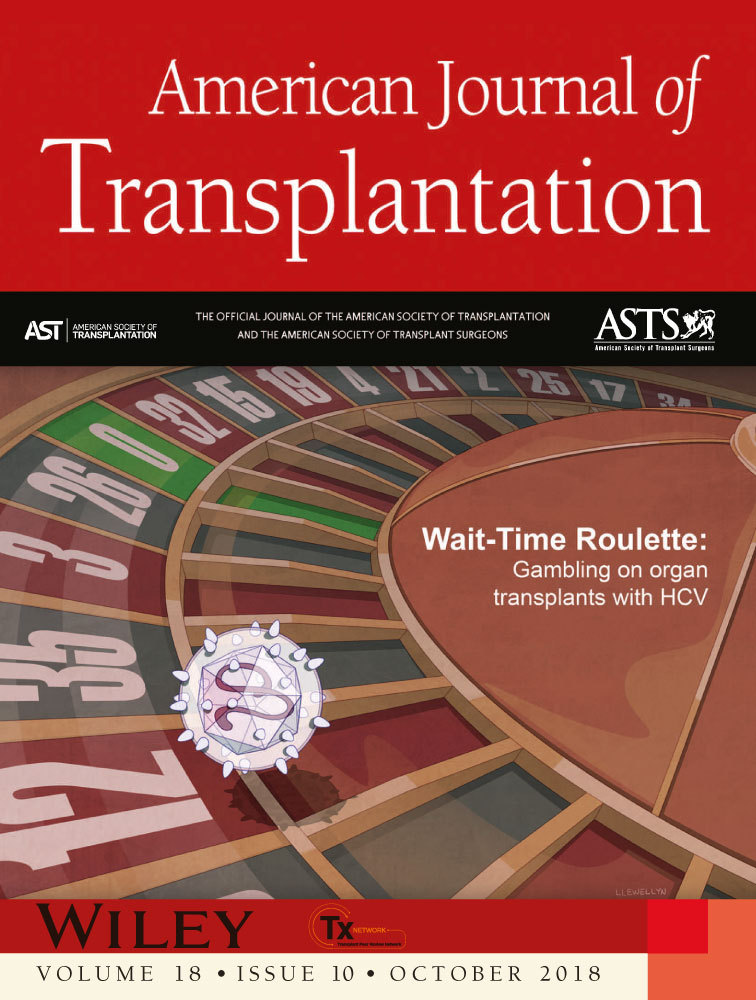Consent and labeling in the use of infectious risk donor kidneys: A response to “Information Overload”
See also: Singh et al
To the Editor:
We thank Singh et al for their interest in our work on the survival benefit conferred by increased infectious risk kidneys (IRD).1 We agree that our findings of substantial benefit and elevated discard rates of IRD kidneys, coupled with existing literature on their low infectious risk, support broader utilization of these so-labeled kidneys. Physicians and patients considering these offers can also turn to our risk calculator (www.transplantmodels.com/ird) to quantify the personalized survival benefit of accepting an IRD kidney versus waiting for the next non-IRD option.2
We believe Singh's attention to the “high risk” label is warranted; arguably the term “high risk” exaggerates the degree of risk conferred by these organs. Depending on the criteria for which the donor was labeled IRD, the risk of window period human immunodeficiency virus infection is only 0.04-4.9 per 10 000,3 and hepatitis C virus (the other major window period concern) can now be cured using direct-acting antiviral therapies. We have previously demonstrated the harmful effect of labeling high-Kidney Donor Profile Index (KDPI) organs, and a similar “labeling effect” likely contributes to IRD discards as well.4 While the argument can be made that we need to understand the granular risk associated with high-KDPI organs, deceased donors labeled IRD tend to be younger and possess fewer comorbidities than those in the overall donor pool. There is broad acceptance in the transplant community for increased utilization of marginal organs, such as those from donors with high terminal creatinine, cardiac death, or obesity, all of which confer greater risk to the recipient but do not bear the “high risk” label.
Evidence of consent burden also supports a timely reevaluation of the United Network for Organ Sharing–required special consent process for IRD kidneys. Even 10 years ago, Halpern et al discussed the need for increased standardization in the timing and progression of consent and a reduction in behavioral risk factor disclosure to improve equity in distribution and reduce stigmatization of these organs.5 Today this argument is still relevant, perhaps even more so as the IRD pool has grown substantially.
Currently, 1 in 5 deceased donors are labeled IRD, and we can expect this number to increase further given the devastating and well-described opioid overdose epidemic that has infiltrated solid organ transplantation.6 If the availability of these organs continues to increase, then the time is ripe for policy changes that minimize the continued and unnecessary discard of otherwise high-quality organs in the current organ shortage. As with any nonstandard organ, the balance between more generalized consent and the patient's right to full disclosure must be maintained. Consent informed by an understanding of risks is a critical safeguard and an ethical responsibility for any medical procedure; this does not mean that a separate, formalized consent process is required for every conceivable source of donor-associated risk. We agree with Singh et al that change is necessary, and we add that it is incumbent upon physicians and policy makers to alleviate the harm induced by misleading labeling and overformalized consent required for IRD kidneys.
Acknowledgments
Funding for this work was provided by the National Institute of Diabetes and Digestive and Kidney Disease (NIDDK) grants K01KD101677 (Massie), K01DK114388 (Henderson), and K24KD101828 (Segev).
Disclosure
The authors of this manuscript have no conflicts of interest to disclose as described by the American Journal of Transplantation.




